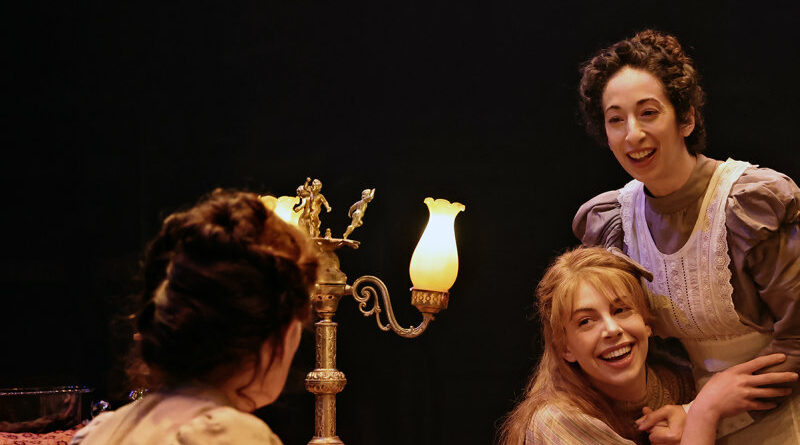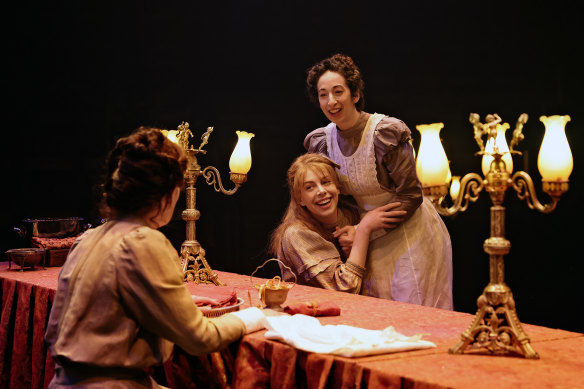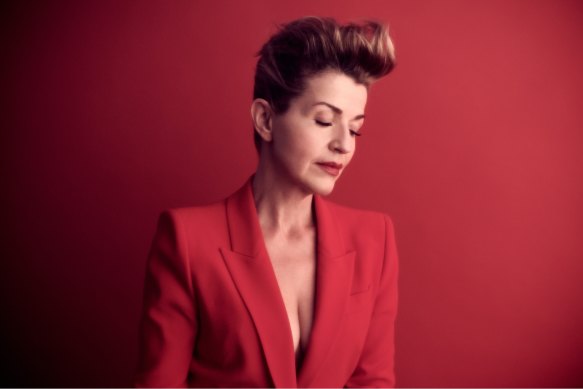A time-spinning epic of love, hate and fossil fuels
Save articles for later
Add articles to your saved list and come back to them any time.
THEATRE
OIL
Wharf 1 Theatre, November 9
Until December 16
Reviewed by JOHN SHAND
★★★½
We get caught in spirals of desire. It happens with alcohol, drugs, food, gambling, shopping and even fossil fuels. We always want more. Perhaps greed is hardwired into us. Ella Hickson’s gravity-defying 2016 play is partly about how that lust for oil shaped 150 years of human history; partly about a specific mother/daughter friction that comes to stand for all such relationships.
Hickson sets each of her five acts in a different era, with an evolving oil dependence. The same mother, May (Brook Satchwell) and daughter Amy (Charlotte Friels) inhabit each era, with Amy simultaneously a spinning metaphor for oil.
The lights come on: Violette Ayad, Charlotte Friels and Brooke Satchwell in Oil.Credit: Prudence Upton
In Act One, set in 1889 Cornwall, kerosene lamps have just been invented and May is pregnant with Amy to Joss, her grand passion, but a husband who confronts the future by clinging to the past. In the second, in 1908 Persia, the British have just begun mining oil, and Amy is a sprightly eight-year-old.
Act Three is in 1970 England, and Amy is an unruly teen, just as Gaddafi’s Libya is bucking against British oil exploitation. For the fourth we’re in 2021 Baghdad, with Amy a 20-something activist appalled by the 2003 invasion, and her mother a British MP who strikes a deal to quadruple Iraqi oil production to help pay for reconstruction.
Finally, we’re shot into 2050 Cornwall, where, with oil running out, a much older Amy and May bicker like sisters over the endless blackouts. Fan Wang (Jing-Xuan Chan) arrives to flog a Toroid, a miniature nuclear reactor that lights and warms their bleak house, just as the first kerosene lamp did in 1889.
Not many people dare to write epics in this age of issues-based plays. Oil, of course, is issues-based, too, but Hickson is never wantonly didactic. She earths the play in an evolving human relationship, and then dares to cut the string to her own balloon in terms of time and place, love and hate, oil and money. As Fan Wang says at the end, “The Western Empire, like the Roman Empire that had come before, made the false assumption that their version of modernity was modernity itself.”
Director Paige Rattray’s STC production does not quite live up to the play. It’s well cast (notably Josh McConville as Joss, the husband whom May forsakes), but doesn’t quite sustain the intensity, or sense of enormity rendered familial, that it should, especially given it’s performed in the round, so we’re all only metres from the action. That intensity is present in the grubby domesticity of 1889, but even then the revelation of the kerosene lamp seems undercooked: the lighting should explode relative to the candlelight in which the family squabbles.
Hickson lets humour creep into her play slyly. It’s there in the satirised hypocrisy of colonial-era Persia, and in the typically stubborn mother-teen fighting of Act Three. The playwright also successfully flirts with a heightened tone, as when May tells Amy’s first (inept) lover, Nate (Callan Colley), “I will not watch her try to believe a god into you.”
Ultimately, as the anagrammatic names suggest, May and Amy are hewn from the same Cornish dirt. Each knows she exists because she fights the world, with May trying to milk it and Amy to save it. Friels is capable of catching Amy’s balloon-off-the-string lightness, and Satchwell can rise to towering rages as May, but we’re not as moved as I suspect we should be.
Anne-Sophie Mutter & the Music of John Williams
Sydney Symphony Orchestra
November 9
Reviewed by PETER McCALLUM
★★★★
Those expecting Star Wars heroics might have been surprised. John Williams’ Violin Concert No. 2, written for legendary violinist Anne-Sophie Mutter, is searching and reflective, seeking humanity rather than galactic domination.
Towards the end of the second movement, Rounds, the music seems to find it, with a motif that breathes a sense of release, and which becomes the focus of the fourth movement, Epilogue. After a quiet, crystalline opening on harp and cello, Mutter entered languorously, moving quickly to intensity, always with that perfectly finished tone: rich, but not over-velvety; sweet, but with complex astringency; golden, but underlaid with unwavering firmness and strength.
Legendary violinist Anne-Sophie Mutter was in searching and reflective mood playing the John Williams concerto written for her.Credit:
The harp, played by Natalie Wong, has a prominent but reserved role throughout, avoiding sweeping glissandi in favour of quiet, clear notes of telling presence, like an attendant spirit who hovers, observes and knows. The second movement begins with quiet burbling from the flutes, rotating in eddying swirls.
The concerto also has vigorous and agitated music, most prominently in the third movement, Dactyls and the violin has other partnerships as well, memorably with bassoon and with flute, and, strikingly in a cadenza with harp and timpani. Released from the narrative requirements of film, Williams has allowed himself to write music that reshapes itself and changes elusively, not bound to a fateful trajectory but shifting with the tide.
Mutter’s partnership with Williams in the concerto provided a setting for Chief Conductor Simone Young and the Sydney Symphony Orchestra to bring other notables from the cinema into the concert hall. Bernard Herrmann’s score for Hitchcock’s Vertigo begins with a simple undulating arpeggio, imbued with a clever hint of tonal disorientation.
The score for Visconti’s 1963 film The Leopard, by Nino Rota, also composer for films by Fellini, Coppola and Zeffirelli, brought a moment of opulent Romantic excess. Nigel Westlake’s Flying Dream, using his music from Robert Connolly’s Paper Planes, opened with a chord that burst like something rich and strange, glittering with hidden luminescence.
This is brilliantly coloured music by Westlake with impressive inventiveness in its orchestration. Mutter then returned for concert arrangements from two of Williams’ film scores. First came the romantic melodiousness of Hedwig’s Theme from Harry Potter and the Philosopher’s Stone (2001), then a virtuosic bravura adaptation of the theme from Robert Altman’s The Long Goodbye (1973), followed by a string of encores. After the artificial ambience of cinema acoustics, Young and the SSO’s renditions of these scores in the concert hall shone with splendid richness and natural colour.
Most Viewed in Culture
From our partners
Source: Read Full Article


